Human Resource Management Case Study: TK Ceramics' Expansion Plans
VerifiedAdded on 2023/01/18
|11
|2998
|29
Case Study
AI Summary
This case study examines TK Ceramics, an Australian ceramic tile importer, and its expansion plans into the Indonesian market. The analysis focuses on the HR challenges arising from this expansion, including redesigning internally and customer-facing jobs, the advantages and disadvantages of internal recruitment, creating job descriptions and person specifications for new shop positions, and comparing the skills required for field sales representatives and shop staff. The paper provides a comprehensive analysis of the HRM practices that can be adopted by the HR manager, Renee, to facilitate smooth operations, including the creation of job descriptions, recruitment strategies, and employee skill assessments. It explores the challenges associated with expansion, and how to effectively manage human resources in a growing company.
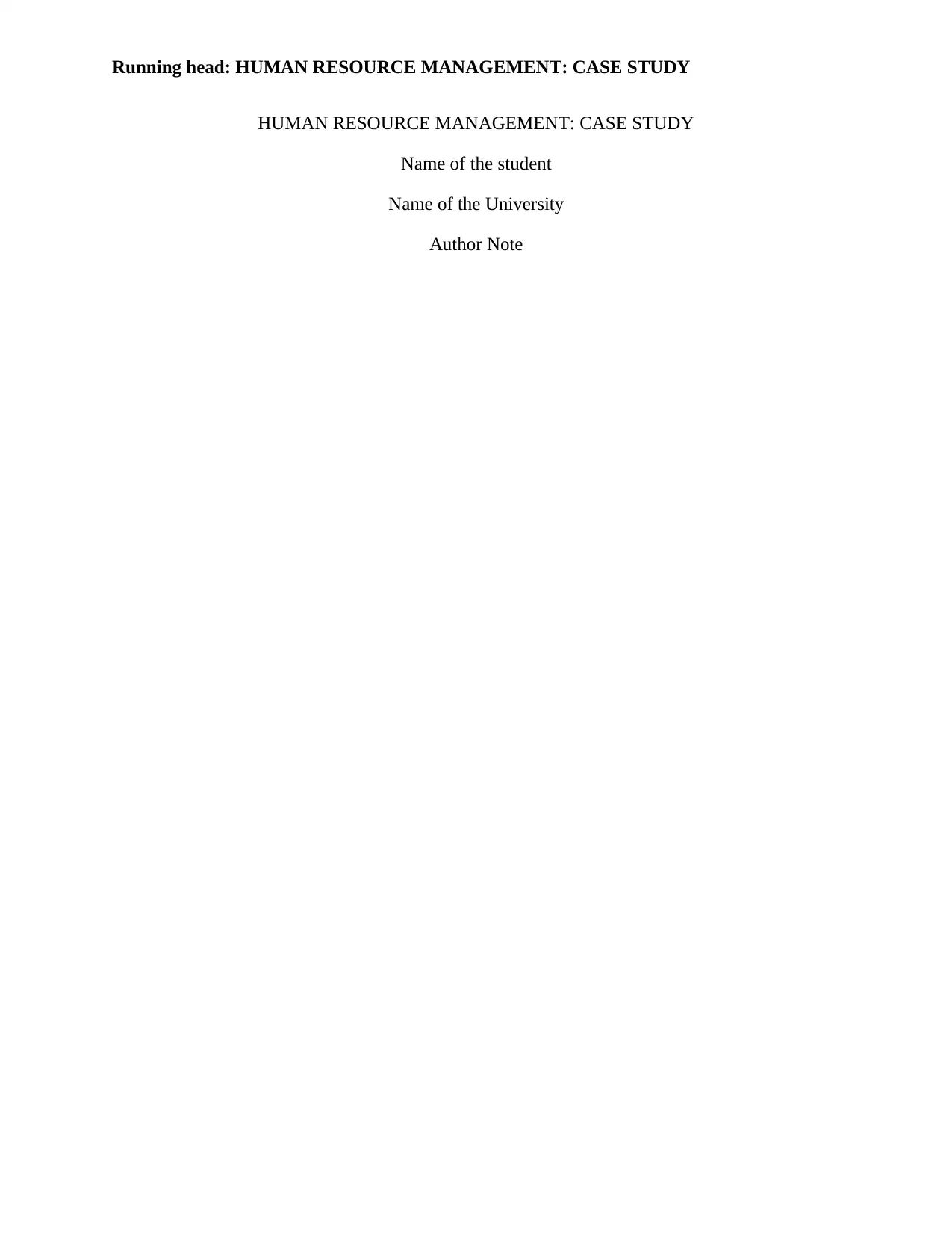
Running head: HUMAN RESOURCE MANAGEMENT: CASE STUDY
HUMAN RESOURCE MANAGEMENT: CASE STUDY
Name of the student
Name of the University
Author Note
HUMAN RESOURCE MANAGEMENT: CASE STUDY
Name of the student
Name of the University
Author Note
Paraphrase This Document
Need a fresh take? Get an instant paraphrase of this document with our AI Paraphraser
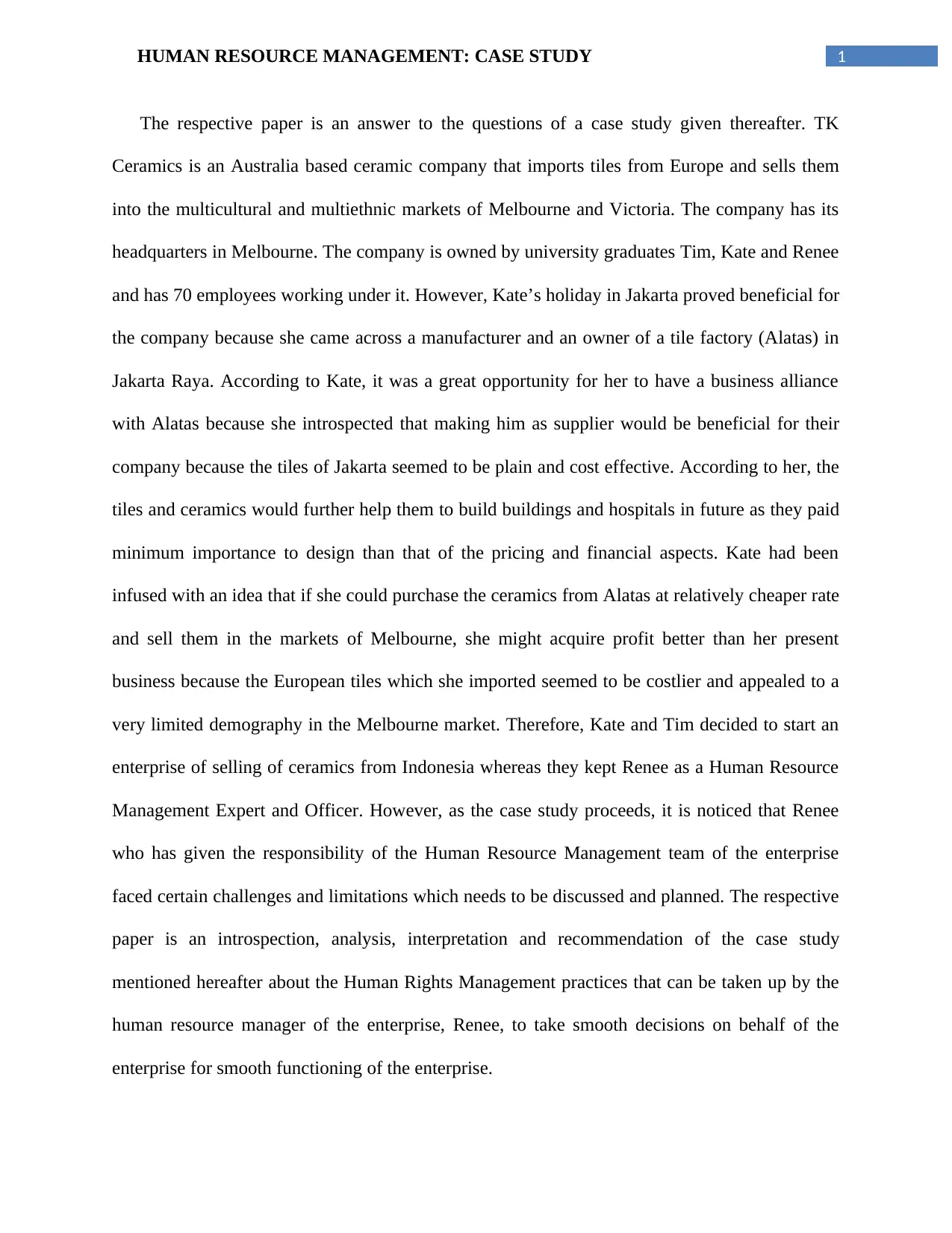
1HUMAN RESOURCE MANAGEMENT: CASE STUDY
The respective paper is an answer to the questions of a case study given thereafter. TK
Ceramics is an Australia based ceramic company that imports tiles from Europe and sells them
into the multicultural and multiethnic markets of Melbourne and Victoria. The company has its
headquarters in Melbourne. The company is owned by university graduates Tim, Kate and Renee
and has 70 employees working under it. However, Kate’s holiday in Jakarta proved beneficial for
the company because she came across a manufacturer and an owner of a tile factory (Alatas) in
Jakarta Raya. According to Kate, it was a great opportunity for her to have a business alliance
with Alatas because she introspected that making him as supplier would be beneficial for their
company because the tiles of Jakarta seemed to be plain and cost effective. According to her, the
tiles and ceramics would further help them to build buildings and hospitals in future as they paid
minimum importance to design than that of the pricing and financial aspects. Kate had been
infused with an idea that if she could purchase the ceramics from Alatas at relatively cheaper rate
and sell them in the markets of Melbourne, she might acquire profit better than her present
business because the European tiles which she imported seemed to be costlier and appealed to a
very limited demography in the Melbourne market. Therefore, Kate and Tim decided to start an
enterprise of selling of ceramics from Indonesia whereas they kept Renee as a Human Resource
Management Expert and Officer. However, as the case study proceeds, it is noticed that Renee
who has given the responsibility of the Human Resource Management team of the enterprise
faced certain challenges and limitations which needs to be discussed and planned. The respective
paper is an introspection, analysis, interpretation and recommendation of the case study
mentioned hereafter about the Human Rights Management practices that can be taken up by the
human resource manager of the enterprise, Renee, to take smooth decisions on behalf of the
enterprise for smooth functioning of the enterprise.
The respective paper is an answer to the questions of a case study given thereafter. TK
Ceramics is an Australia based ceramic company that imports tiles from Europe and sells them
into the multicultural and multiethnic markets of Melbourne and Victoria. The company has its
headquarters in Melbourne. The company is owned by university graduates Tim, Kate and Renee
and has 70 employees working under it. However, Kate’s holiday in Jakarta proved beneficial for
the company because she came across a manufacturer and an owner of a tile factory (Alatas) in
Jakarta Raya. According to Kate, it was a great opportunity for her to have a business alliance
with Alatas because she introspected that making him as supplier would be beneficial for their
company because the tiles of Jakarta seemed to be plain and cost effective. According to her, the
tiles and ceramics would further help them to build buildings and hospitals in future as they paid
minimum importance to design than that of the pricing and financial aspects. Kate had been
infused with an idea that if she could purchase the ceramics from Alatas at relatively cheaper rate
and sell them in the markets of Melbourne, she might acquire profit better than her present
business because the European tiles which she imported seemed to be costlier and appealed to a
very limited demography in the Melbourne market. Therefore, Kate and Tim decided to start an
enterprise of selling of ceramics from Indonesia whereas they kept Renee as a Human Resource
Management Expert and Officer. However, as the case study proceeds, it is noticed that Renee
who has given the responsibility of the Human Resource Management team of the enterprise
faced certain challenges and limitations which needs to be discussed and planned. The respective
paper is an introspection, analysis, interpretation and recommendation of the case study
mentioned hereafter about the Human Rights Management practices that can be taken up by the
human resource manager of the enterprise, Renee, to take smooth decisions on behalf of the
enterprise for smooth functioning of the enterprise.
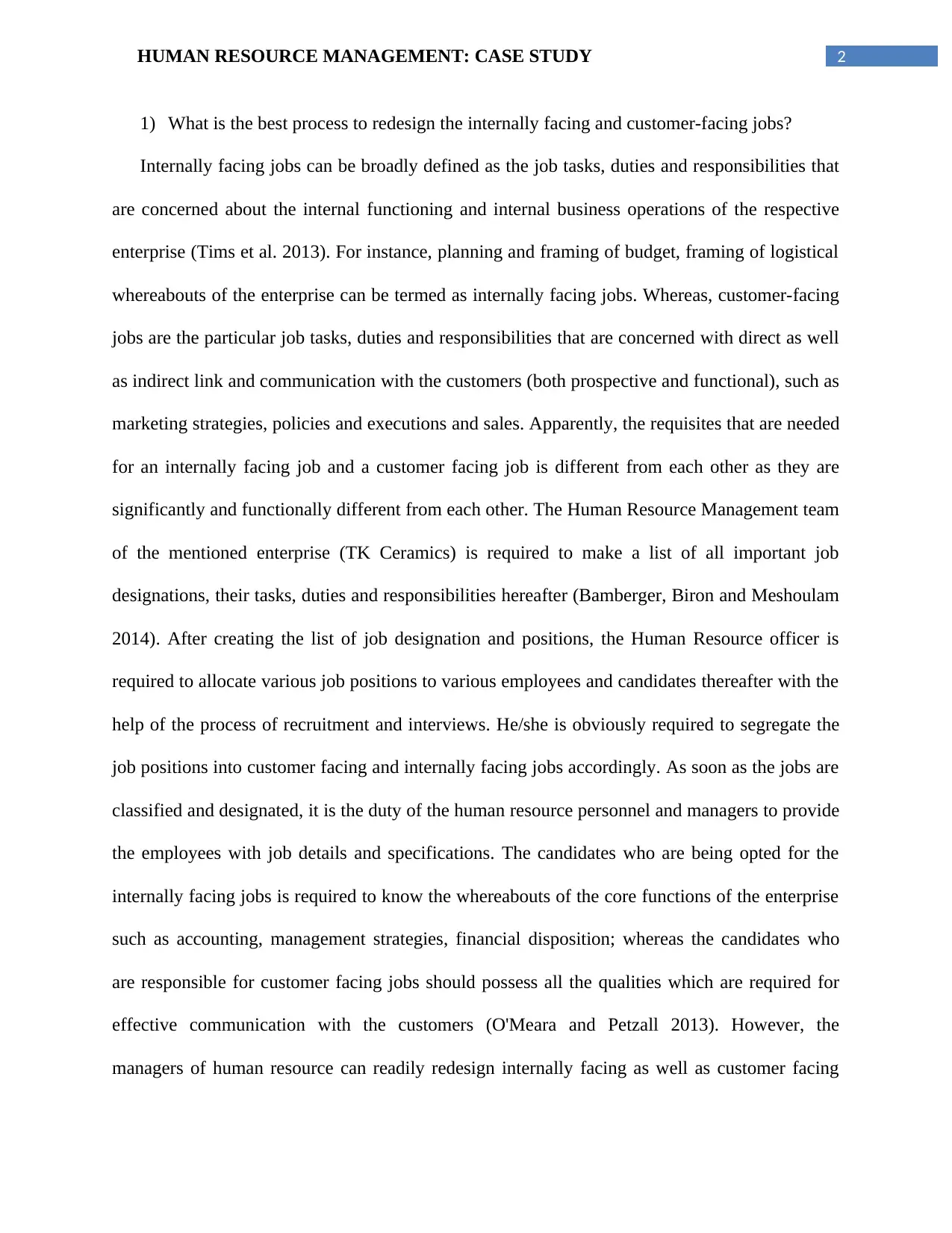
2HUMAN RESOURCE MANAGEMENT: CASE STUDY
1) What is the best process to redesign the internally facing and customer-facing jobs?
Internally facing jobs can be broadly defined as the job tasks, duties and responsibilities that
are concerned about the internal functioning and internal business operations of the respective
enterprise (Tims et al. 2013). For instance, planning and framing of budget, framing of logistical
whereabouts of the enterprise can be termed as internally facing jobs. Whereas, customer-facing
jobs are the particular job tasks, duties and responsibilities that are concerned with direct as well
as indirect link and communication with the customers (both prospective and functional), such as
marketing strategies, policies and executions and sales. Apparently, the requisites that are needed
for an internally facing job and a customer facing job is different from each other as they are
significantly and functionally different from each other. The Human Resource Management team
of the mentioned enterprise (TK Ceramics) is required to make a list of all important job
designations, their tasks, duties and responsibilities hereafter (Bamberger, Biron and Meshoulam
2014). After creating the list of job designation and positions, the Human Resource officer is
required to allocate various job positions to various employees and candidates thereafter with the
help of the process of recruitment and interviews. He/she is obviously required to segregate the
job positions into customer facing and internally facing jobs accordingly. As soon as the jobs are
classified and designated, it is the duty of the human resource personnel and managers to provide
the employees with job details and specifications. The candidates who are being opted for the
internally facing jobs is required to know the whereabouts of the core functions of the enterprise
such as accounting, management strategies, financial disposition; whereas the candidates who
are responsible for customer facing jobs should possess all the qualities which are required for
effective communication with the customers (O'Meara and Petzall 2013). However, the
managers of human resource can readily redesign internally facing as well as customer facing
1) What is the best process to redesign the internally facing and customer-facing jobs?
Internally facing jobs can be broadly defined as the job tasks, duties and responsibilities that
are concerned about the internal functioning and internal business operations of the respective
enterprise (Tims et al. 2013). For instance, planning and framing of budget, framing of logistical
whereabouts of the enterprise can be termed as internally facing jobs. Whereas, customer-facing
jobs are the particular job tasks, duties and responsibilities that are concerned with direct as well
as indirect link and communication with the customers (both prospective and functional), such as
marketing strategies, policies and executions and sales. Apparently, the requisites that are needed
for an internally facing job and a customer facing job is different from each other as they are
significantly and functionally different from each other. The Human Resource Management team
of the mentioned enterprise (TK Ceramics) is required to make a list of all important job
designations, their tasks, duties and responsibilities hereafter (Bamberger, Biron and Meshoulam
2014). After creating the list of job designation and positions, the Human Resource officer is
required to allocate various job positions to various employees and candidates thereafter with the
help of the process of recruitment and interviews. He/she is obviously required to segregate the
job positions into customer facing and internally facing jobs accordingly. As soon as the jobs are
classified and designated, it is the duty of the human resource personnel and managers to provide
the employees with job details and specifications. The candidates who are being opted for the
internally facing jobs is required to know the whereabouts of the core functions of the enterprise
such as accounting, management strategies, financial disposition; whereas the candidates who
are responsible for customer facing jobs should possess all the qualities which are required for
effective communication with the customers (O'Meara and Petzall 2013). However, the
managers of human resource can readily redesign internally facing as well as customer facing
⊘ This is a preview!⊘
Do you want full access?
Subscribe today to unlock all pages.

Trusted by 1+ million students worldwide
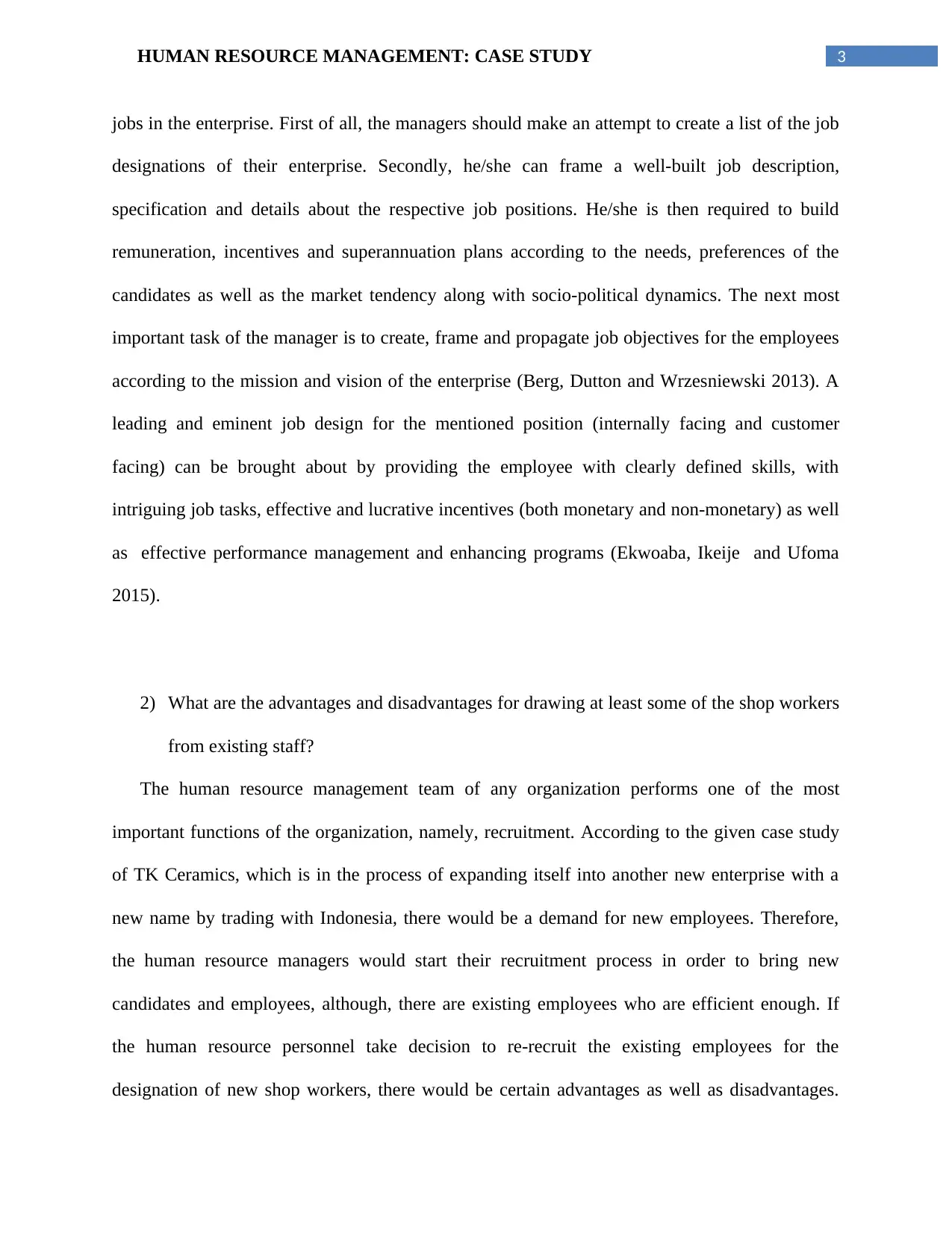
3HUMAN RESOURCE MANAGEMENT: CASE STUDY
jobs in the enterprise. First of all, the managers should make an attempt to create a list of the job
designations of their enterprise. Secondly, he/she can frame a well-built job description,
specification and details about the respective job positions. He/she is then required to build
remuneration, incentives and superannuation plans according to the needs, preferences of the
candidates as well as the market tendency along with socio-political dynamics. The next most
important task of the manager is to create, frame and propagate job objectives for the employees
according to the mission and vision of the enterprise (Berg, Dutton and Wrzesniewski 2013). A
leading and eminent job design for the mentioned position (internally facing and customer
facing) can be brought about by providing the employee with clearly defined skills, with
intriguing job tasks, effective and lucrative incentives (both monetary and non-monetary) as well
as effective performance management and enhancing programs (Ekwoaba, Ikeije and Ufoma
2015).
2) What are the advantages and disadvantages for drawing at least some of the shop workers
from existing staff?
The human resource management team of any organization performs one of the most
important functions of the organization, namely, recruitment. According to the given case study
of TK Ceramics, which is in the process of expanding itself into another new enterprise with a
new name by trading with Indonesia, there would be a demand for new employees. Therefore,
the human resource managers would start their recruitment process in order to bring new
candidates and employees, although, there are existing employees who are efficient enough. If
the human resource personnel take decision to re-recruit the existing employees for the
designation of new shop workers, there would be certain advantages as well as disadvantages.
jobs in the enterprise. First of all, the managers should make an attempt to create a list of the job
designations of their enterprise. Secondly, he/she can frame a well-built job description,
specification and details about the respective job positions. He/she is then required to build
remuneration, incentives and superannuation plans according to the needs, preferences of the
candidates as well as the market tendency along with socio-political dynamics. The next most
important task of the manager is to create, frame and propagate job objectives for the employees
according to the mission and vision of the enterprise (Berg, Dutton and Wrzesniewski 2013). A
leading and eminent job design for the mentioned position (internally facing and customer
facing) can be brought about by providing the employee with clearly defined skills, with
intriguing job tasks, effective and lucrative incentives (both monetary and non-monetary) as well
as effective performance management and enhancing programs (Ekwoaba, Ikeije and Ufoma
2015).
2) What are the advantages and disadvantages for drawing at least some of the shop workers
from existing staff?
The human resource management team of any organization performs one of the most
important functions of the organization, namely, recruitment. According to the given case study
of TK Ceramics, which is in the process of expanding itself into another new enterprise with a
new name by trading with Indonesia, there would be a demand for new employees. Therefore,
the human resource managers would start their recruitment process in order to bring new
candidates and employees, although, there are existing employees who are efficient enough. If
the human resource personnel take decision to re-recruit the existing employees for the
designation of new shop workers, there would be certain advantages as well as disadvantages.
Paraphrase This Document
Need a fresh take? Get an instant paraphrase of this document with our AI Paraphraser
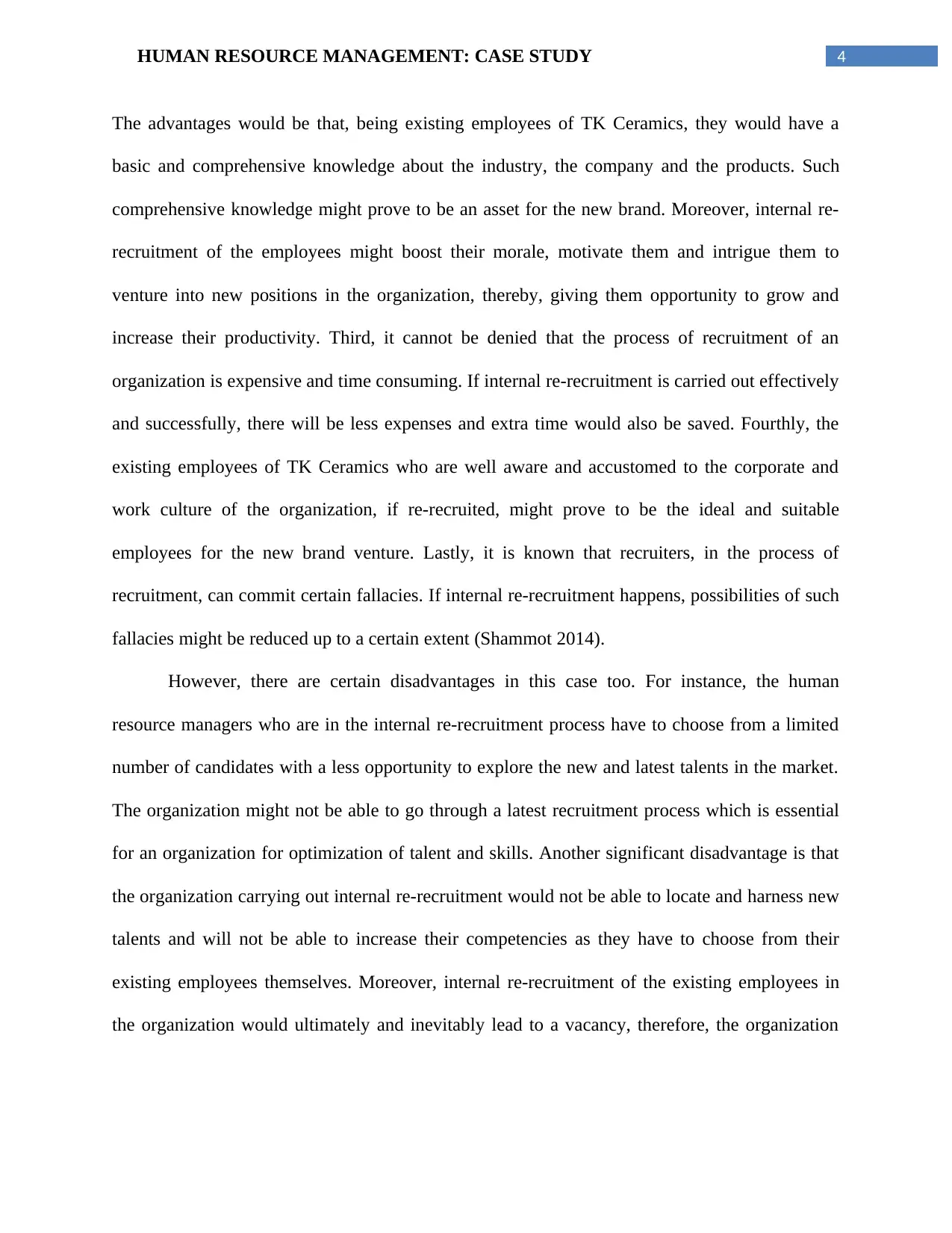
4HUMAN RESOURCE MANAGEMENT: CASE STUDY
The advantages would be that, being existing employees of TK Ceramics, they would have a
basic and comprehensive knowledge about the industry, the company and the products. Such
comprehensive knowledge might prove to be an asset for the new brand. Moreover, internal re-
recruitment of the employees might boost their morale, motivate them and intrigue them to
venture into new positions in the organization, thereby, giving them opportunity to grow and
increase their productivity. Third, it cannot be denied that the process of recruitment of an
organization is expensive and time consuming. If internal re-recruitment is carried out effectively
and successfully, there will be less expenses and extra time would also be saved. Fourthly, the
existing employees of TK Ceramics who are well aware and accustomed to the corporate and
work culture of the organization, if re-recruited, might prove to be the ideal and suitable
employees for the new brand venture. Lastly, it is known that recruiters, in the process of
recruitment, can commit certain fallacies. If internal re-recruitment happens, possibilities of such
fallacies might be reduced up to a certain extent (Shammot 2014).
However, there are certain disadvantages in this case too. For instance, the human
resource managers who are in the internal re-recruitment process have to choose from a limited
number of candidates with a less opportunity to explore the new and latest talents in the market.
The organization might not be able to go through a latest recruitment process which is essential
for an organization for optimization of talent and skills. Another significant disadvantage is that
the organization carrying out internal re-recruitment would not be able to locate and harness new
talents and will not be able to increase their competencies as they have to choose from their
existing employees themselves. Moreover, internal re-recruitment of the existing employees in
the organization would ultimately and inevitably lead to a vacancy, therefore, the organization
The advantages would be that, being existing employees of TK Ceramics, they would have a
basic and comprehensive knowledge about the industry, the company and the products. Such
comprehensive knowledge might prove to be an asset for the new brand. Moreover, internal re-
recruitment of the employees might boost their morale, motivate them and intrigue them to
venture into new positions in the organization, thereby, giving them opportunity to grow and
increase their productivity. Third, it cannot be denied that the process of recruitment of an
organization is expensive and time consuming. If internal re-recruitment is carried out effectively
and successfully, there will be less expenses and extra time would also be saved. Fourthly, the
existing employees of TK Ceramics who are well aware and accustomed to the corporate and
work culture of the organization, if re-recruited, might prove to be the ideal and suitable
employees for the new brand venture. Lastly, it is known that recruiters, in the process of
recruitment, can commit certain fallacies. If internal re-recruitment happens, possibilities of such
fallacies might be reduced up to a certain extent (Shammot 2014).
However, there are certain disadvantages in this case too. For instance, the human
resource managers who are in the internal re-recruitment process have to choose from a limited
number of candidates with a less opportunity to explore the new and latest talents in the market.
The organization might not be able to go through a latest recruitment process which is essential
for an organization for optimization of talent and skills. Another significant disadvantage is that
the organization carrying out internal re-recruitment would not be able to locate and harness new
talents and will not be able to increase their competencies as they have to choose from their
existing employees themselves. Moreover, internal re-recruitment of the existing employees in
the organization would ultimately and inevitably lead to a vacancy, therefore, the organization
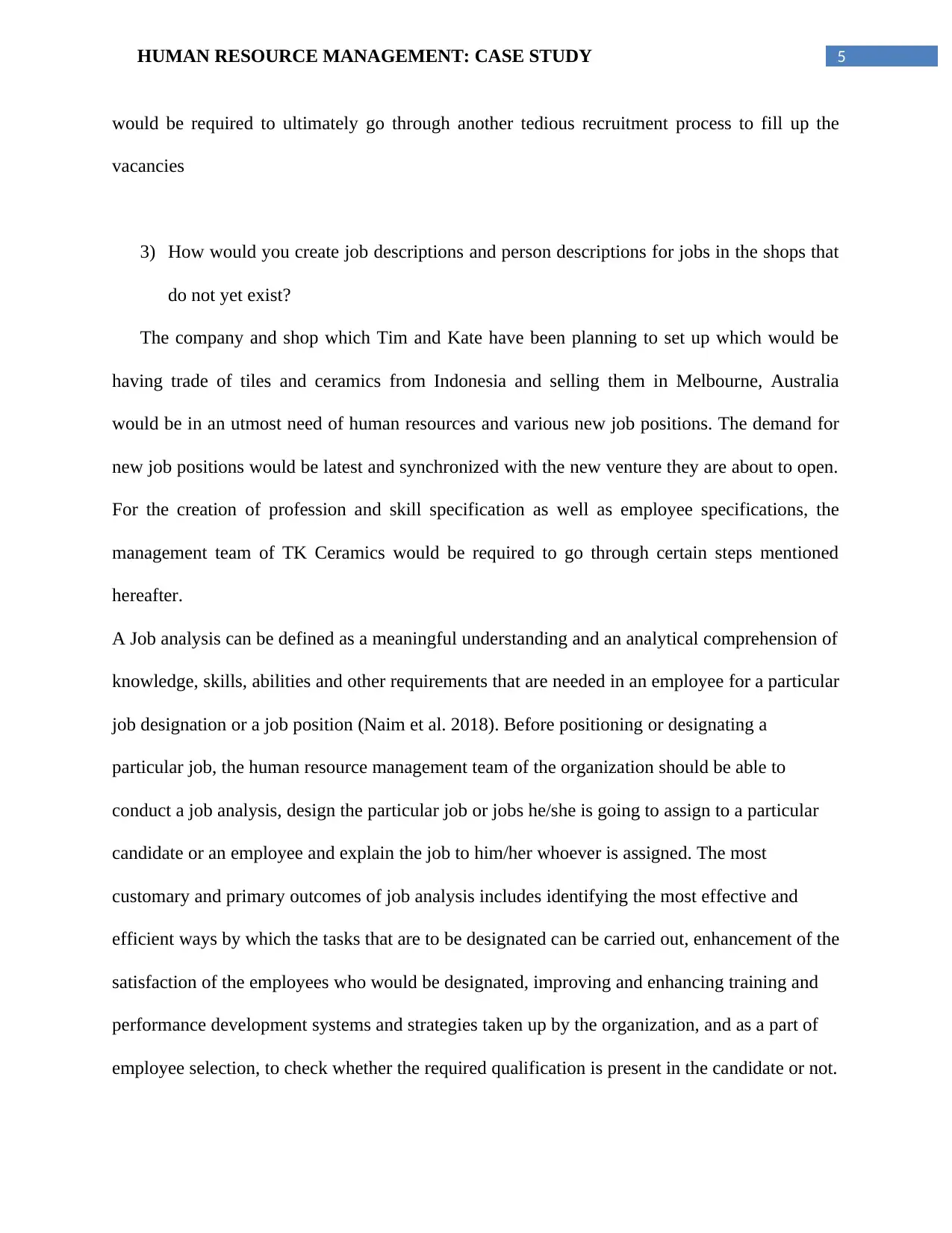
5HUMAN RESOURCE MANAGEMENT: CASE STUDY
would be required to ultimately go through another tedious recruitment process to fill up the
vacancies
3) How would you create job descriptions and person descriptions for jobs in the shops that
do not yet exist?
The company and shop which Tim and Kate have been planning to set up which would be
having trade of tiles and ceramics from Indonesia and selling them in Melbourne, Australia
would be in an utmost need of human resources and various new job positions. The demand for
new job positions would be latest and synchronized with the new venture they are about to open.
For the creation of profession and skill specification as well as employee specifications, the
management team of TK Ceramics would be required to go through certain steps mentioned
hereafter.
A Job analysis can be defined as a meaningful understanding and an analytical comprehension of
knowledge, skills, abilities and other requirements that are needed in an employee for a particular
job designation or a job position (Naim et al. 2018). Before positioning or designating a
particular job, the human resource management team of the organization should be able to
conduct a job analysis, design the particular job or jobs he/she is going to assign to a particular
candidate or an employee and explain the job to him/her whoever is assigned. The most
customary and primary outcomes of job analysis includes identifying the most effective and
efficient ways by which the tasks that are to be designated can be carried out, enhancement of the
satisfaction of the employees who would be designated, improving and enhancing training and
performance development systems and strategies taken up by the organization, and as a part of
employee selection, to check whether the required qualification is present in the candidate or not.
would be required to ultimately go through another tedious recruitment process to fill up the
vacancies
3) How would you create job descriptions and person descriptions for jobs in the shops that
do not yet exist?
The company and shop which Tim and Kate have been planning to set up which would be
having trade of tiles and ceramics from Indonesia and selling them in Melbourne, Australia
would be in an utmost need of human resources and various new job positions. The demand for
new job positions would be latest and synchronized with the new venture they are about to open.
For the creation of profession and skill specification as well as employee specifications, the
management team of TK Ceramics would be required to go through certain steps mentioned
hereafter.
A Job analysis can be defined as a meaningful understanding and an analytical comprehension of
knowledge, skills, abilities and other requirements that are needed in an employee for a particular
job designation or a job position (Naim et al. 2018). Before positioning or designating a
particular job, the human resource management team of the organization should be able to
conduct a job analysis, design the particular job or jobs he/she is going to assign to a particular
candidate or an employee and explain the job to him/her whoever is assigned. The most
customary and primary outcomes of job analysis includes identifying the most effective and
efficient ways by which the tasks that are to be designated can be carried out, enhancement of the
satisfaction of the employees who would be designated, improving and enhancing training and
performance development systems and strategies taken up by the organization, and as a part of
employee selection, to check whether the required qualification is present in the candidate or not.
⊘ This is a preview!⊘
Do you want full access?
Subscribe today to unlock all pages.

Trusted by 1+ million students worldwide
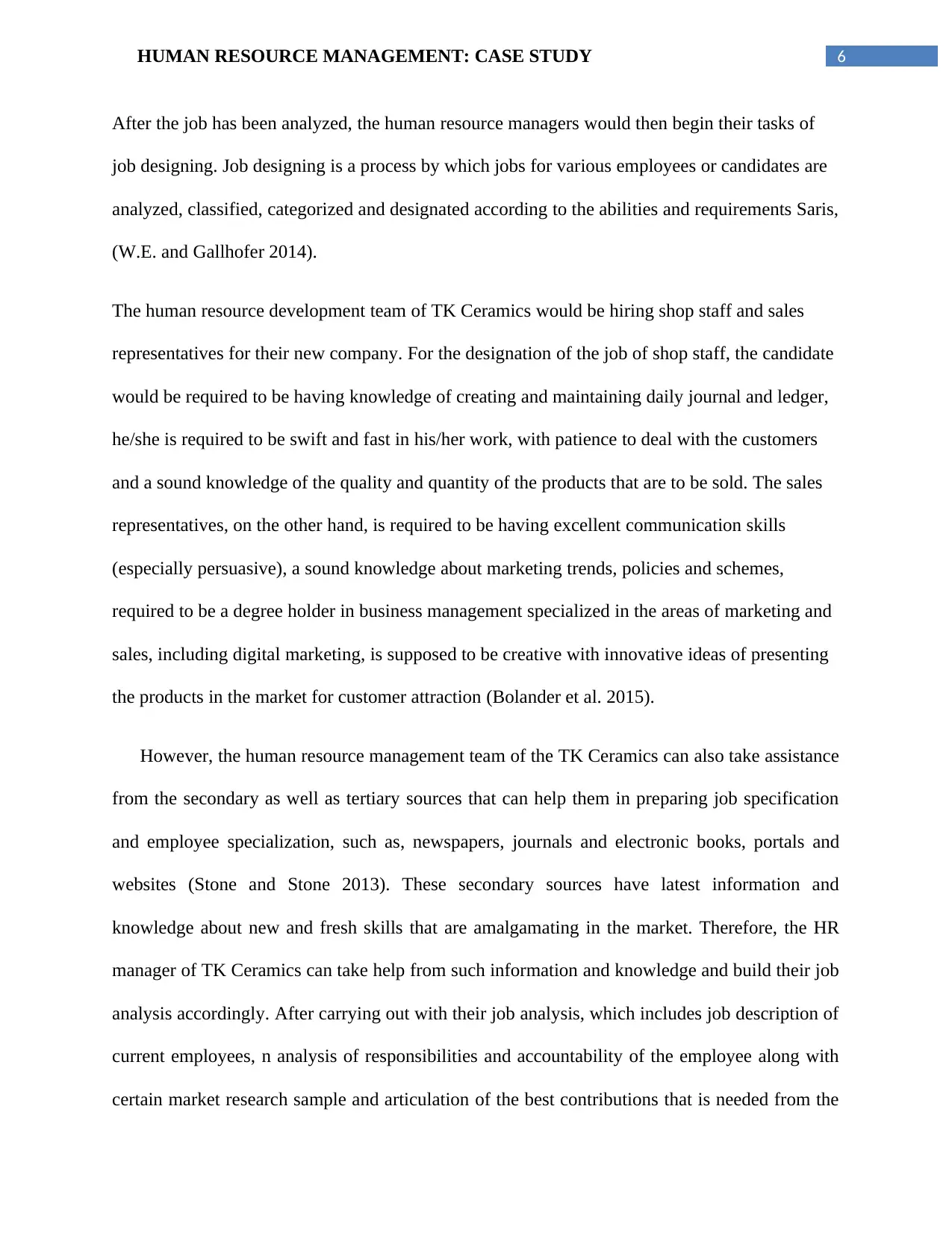
6HUMAN RESOURCE MANAGEMENT: CASE STUDY
After the job has been analyzed, the human resource managers would then begin their tasks of
job designing. Job designing is a process by which jobs for various employees or candidates are
analyzed, classified, categorized and designated according to the abilities and requirements Saris,
(W.E. and Gallhofer 2014).
The human resource development team of TK Ceramics would be hiring shop staff and sales
representatives for their new company. For the designation of the job of shop staff, the candidate
would be required to be having knowledge of creating and maintaining daily journal and ledger,
he/she is required to be swift and fast in his/her work, with patience to deal with the customers
and a sound knowledge of the quality and quantity of the products that are to be sold. The sales
representatives, on the other hand, is required to be having excellent communication skills
(especially persuasive), a sound knowledge about marketing trends, policies and schemes,
required to be a degree holder in business management specialized in the areas of marketing and
sales, including digital marketing, is supposed to be creative with innovative ideas of presenting
the products in the market for customer attraction (Bolander et al. 2015).
However, the human resource management team of the TK Ceramics can also take assistance
from the secondary as well as tertiary sources that can help them in preparing job specification
and employee specialization, such as, newspapers, journals and electronic books, portals and
websites (Stone and Stone 2013). These secondary sources have latest information and
knowledge about new and fresh skills that are amalgamating in the market. Therefore, the HR
manager of TK Ceramics can take help from such information and knowledge and build their job
analysis accordingly. After carrying out with their job analysis, which includes job description of
current employees, n analysis of responsibilities and accountability of the employee along with
certain market research sample and articulation of the best contributions that is needed from the
After the job has been analyzed, the human resource managers would then begin their tasks of
job designing. Job designing is a process by which jobs for various employees or candidates are
analyzed, classified, categorized and designated according to the abilities and requirements Saris,
(W.E. and Gallhofer 2014).
The human resource development team of TK Ceramics would be hiring shop staff and sales
representatives for their new company. For the designation of the job of shop staff, the candidate
would be required to be having knowledge of creating and maintaining daily journal and ledger,
he/she is required to be swift and fast in his/her work, with patience to deal with the customers
and a sound knowledge of the quality and quantity of the products that are to be sold. The sales
representatives, on the other hand, is required to be having excellent communication skills
(especially persuasive), a sound knowledge about marketing trends, policies and schemes,
required to be a degree holder in business management specialized in the areas of marketing and
sales, including digital marketing, is supposed to be creative with innovative ideas of presenting
the products in the market for customer attraction (Bolander et al. 2015).
However, the human resource management team of the TK Ceramics can also take assistance
from the secondary as well as tertiary sources that can help them in preparing job specification
and employee specialization, such as, newspapers, journals and electronic books, portals and
websites (Stone and Stone 2013). These secondary sources have latest information and
knowledge about new and fresh skills that are amalgamating in the market. Therefore, the HR
manager of TK Ceramics can take help from such information and knowledge and build their job
analysis accordingly. After carrying out with their job analysis, which includes job description of
current employees, n analysis of responsibilities and accountability of the employee along with
certain market research sample and articulation of the best contributions that is needed from the
Paraphrase This Document
Need a fresh take? Get an instant paraphrase of this document with our AI Paraphraser
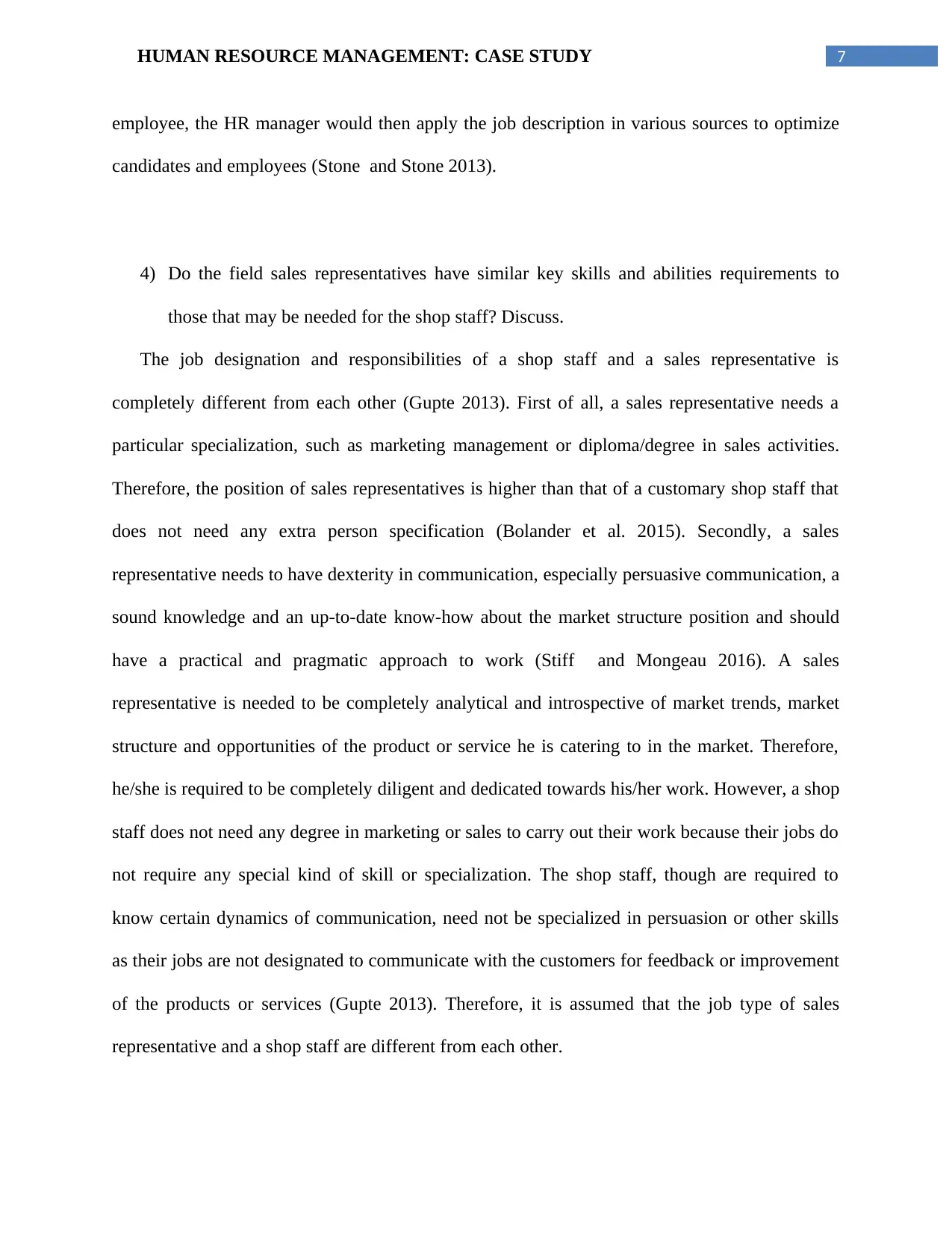
7HUMAN RESOURCE MANAGEMENT: CASE STUDY
employee, the HR manager would then apply the job description in various sources to optimize
candidates and employees (Stone and Stone 2013).
4) Do the field sales representatives have similar key skills and abilities requirements to
those that may be needed for the shop staff? Discuss.
The job designation and responsibilities of a shop staff and a sales representative is
completely different from each other (Gupte 2013). First of all, a sales representative needs a
particular specialization, such as marketing management or diploma/degree in sales activities.
Therefore, the position of sales representatives is higher than that of a customary shop staff that
does not need any extra person specification (Bolander et al. 2015). Secondly, a sales
representative needs to have dexterity in communication, especially persuasive communication, a
sound knowledge and an up-to-date know-how about the market structure position and should
have a practical and pragmatic approach to work (Stiff and Mongeau 2016). A sales
representative is needed to be completely analytical and introspective of market trends, market
structure and opportunities of the product or service he is catering to in the market. Therefore,
he/she is required to be completely diligent and dedicated towards his/her work. However, a shop
staff does not need any degree in marketing or sales to carry out their work because their jobs do
not require any special kind of skill or specialization. The shop staff, though are required to
know certain dynamics of communication, need not be specialized in persuasion or other skills
as their jobs are not designated to communicate with the customers for feedback or improvement
of the products or services (Gupte 2013). Therefore, it is assumed that the job type of sales
representative and a shop staff are different from each other.
employee, the HR manager would then apply the job description in various sources to optimize
candidates and employees (Stone and Stone 2013).
4) Do the field sales representatives have similar key skills and abilities requirements to
those that may be needed for the shop staff? Discuss.
The job designation and responsibilities of a shop staff and a sales representative is
completely different from each other (Gupte 2013). First of all, a sales representative needs a
particular specialization, such as marketing management or diploma/degree in sales activities.
Therefore, the position of sales representatives is higher than that of a customary shop staff that
does not need any extra person specification (Bolander et al. 2015). Secondly, a sales
representative needs to have dexterity in communication, especially persuasive communication, a
sound knowledge and an up-to-date know-how about the market structure position and should
have a practical and pragmatic approach to work (Stiff and Mongeau 2016). A sales
representative is needed to be completely analytical and introspective of market trends, market
structure and opportunities of the product or service he is catering to in the market. Therefore,
he/she is required to be completely diligent and dedicated towards his/her work. However, a shop
staff does not need any degree in marketing or sales to carry out their work because their jobs do
not require any special kind of skill or specialization. The shop staff, though are required to
know certain dynamics of communication, need not be specialized in persuasion or other skills
as their jobs are not designated to communicate with the customers for feedback or improvement
of the products or services (Gupte 2013). Therefore, it is assumed that the job type of sales
representative and a shop staff are different from each other.
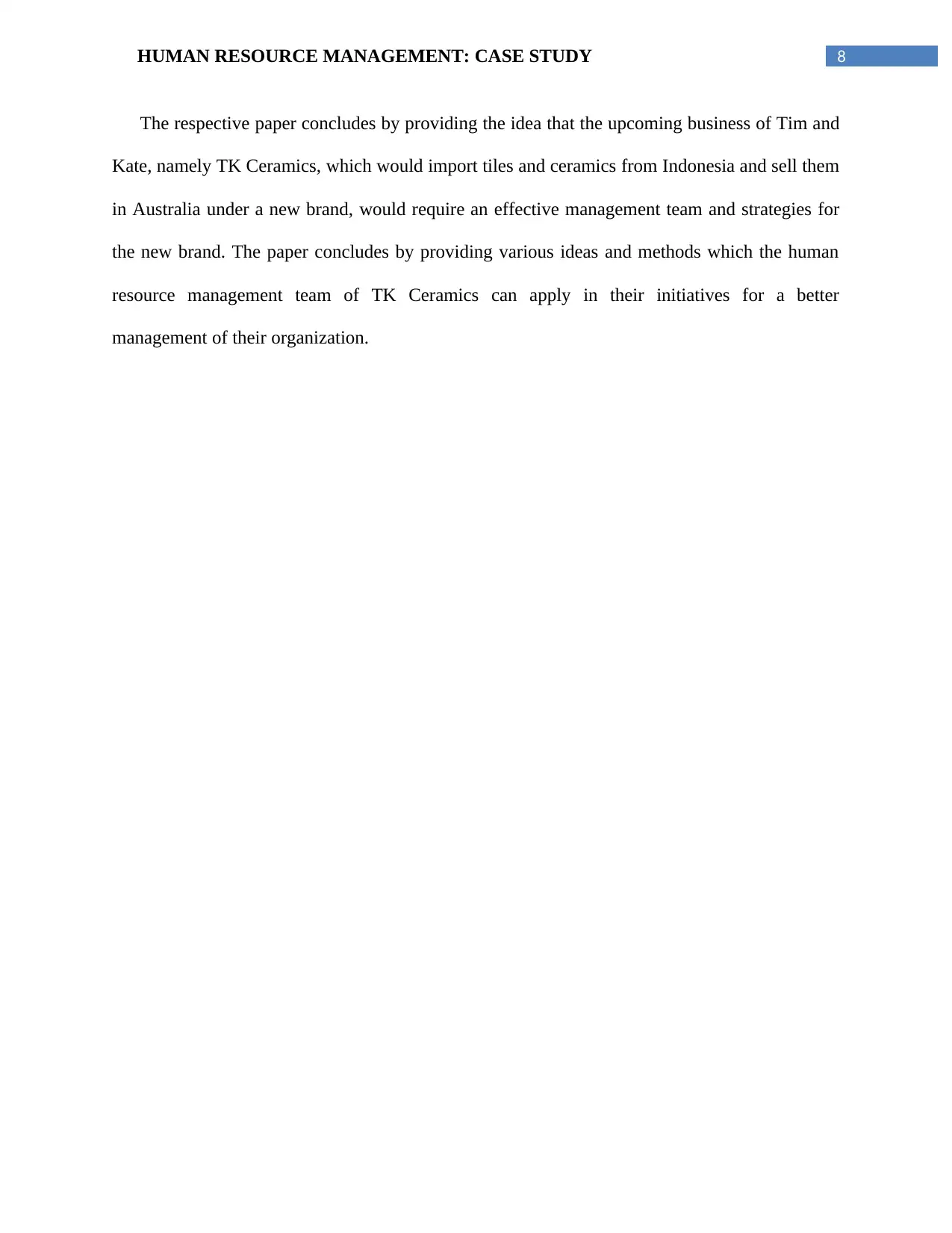
8HUMAN RESOURCE MANAGEMENT: CASE STUDY
The respective paper concludes by providing the idea that the upcoming business of Tim and
Kate, namely TK Ceramics, which would import tiles and ceramics from Indonesia and sell them
in Australia under a new brand, would require an effective management team and strategies for
the new brand. The paper concludes by providing various ideas and methods which the human
resource management team of TK Ceramics can apply in their initiatives for a better
management of their organization.
The respective paper concludes by providing the idea that the upcoming business of Tim and
Kate, namely TK Ceramics, which would import tiles and ceramics from Indonesia and sell them
in Australia under a new brand, would require an effective management team and strategies for
the new brand. The paper concludes by providing various ideas and methods which the human
resource management team of TK Ceramics can apply in their initiatives for a better
management of their organization.
⊘ This is a preview!⊘
Do you want full access?
Subscribe today to unlock all pages.

Trusted by 1+ million students worldwide
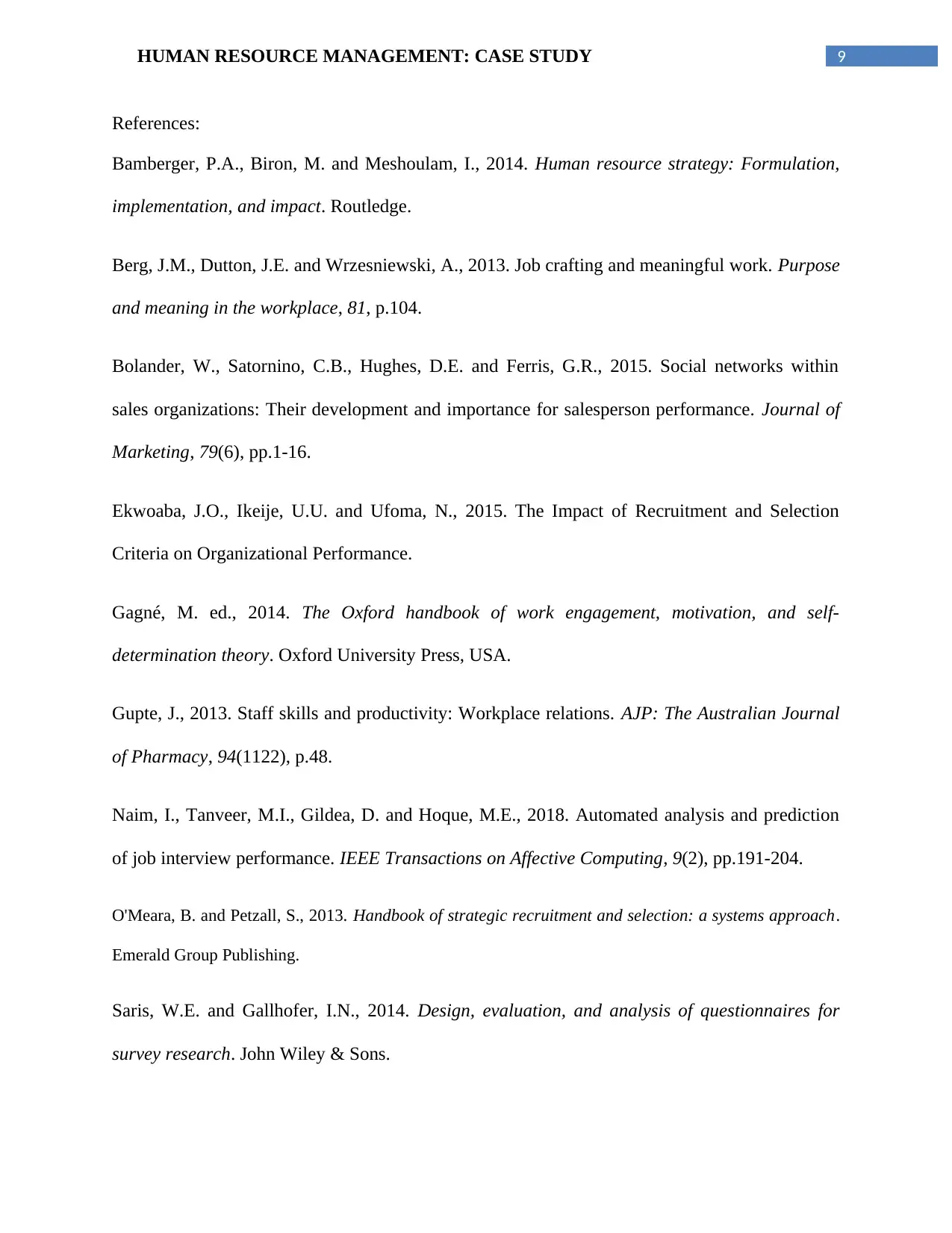
9HUMAN RESOURCE MANAGEMENT: CASE STUDY
References:
Bamberger, P.A., Biron, M. and Meshoulam, I., 2014. Human resource strategy: Formulation,
implementation, and impact. Routledge.
Berg, J.M., Dutton, J.E. and Wrzesniewski, A., 2013. Job crafting and meaningful work. Purpose
and meaning in the workplace, 81, p.104.
Bolander, W., Satornino, C.B., Hughes, D.E. and Ferris, G.R., 2015. Social networks within
sales organizations: Their development and importance for salesperson performance. Journal of
Marketing, 79(6), pp.1-16.
Ekwoaba, J.O., Ikeije, U.U. and Ufoma, N., 2015. The Impact of Recruitment and Selection
Criteria on Organizational Performance.
Gagné, M. ed., 2014. The Oxford handbook of work engagement, motivation, and self-
determination theory. Oxford University Press, USA.
Gupte, J., 2013. Staff skills and productivity: Workplace relations. AJP: The Australian Journal
of Pharmacy, 94(1122), p.48.
Naim, I., Tanveer, M.I., Gildea, D. and Hoque, M.E., 2018. Automated analysis and prediction
of job interview performance. IEEE Transactions on Affective Computing, 9(2), pp.191-204.
O'Meara, B. and Petzall, S., 2013. Handbook of strategic recruitment and selection: a systems approach.
Emerald Group Publishing.
Saris, W.E. and Gallhofer, I.N., 2014. Design, evaluation, and analysis of questionnaires for
survey research. John Wiley & Sons.
References:
Bamberger, P.A., Biron, M. and Meshoulam, I., 2014. Human resource strategy: Formulation,
implementation, and impact. Routledge.
Berg, J.M., Dutton, J.E. and Wrzesniewski, A., 2013. Job crafting and meaningful work. Purpose
and meaning in the workplace, 81, p.104.
Bolander, W., Satornino, C.B., Hughes, D.E. and Ferris, G.R., 2015. Social networks within
sales organizations: Their development and importance for salesperson performance. Journal of
Marketing, 79(6), pp.1-16.
Ekwoaba, J.O., Ikeije, U.U. and Ufoma, N., 2015. The Impact of Recruitment and Selection
Criteria on Organizational Performance.
Gagné, M. ed., 2014. The Oxford handbook of work engagement, motivation, and self-
determination theory. Oxford University Press, USA.
Gupte, J., 2013. Staff skills and productivity: Workplace relations. AJP: The Australian Journal
of Pharmacy, 94(1122), p.48.
Naim, I., Tanveer, M.I., Gildea, D. and Hoque, M.E., 2018. Automated analysis and prediction
of job interview performance. IEEE Transactions on Affective Computing, 9(2), pp.191-204.
O'Meara, B. and Petzall, S., 2013. Handbook of strategic recruitment and selection: a systems approach.
Emerald Group Publishing.
Saris, W.E. and Gallhofer, I.N., 2014. Design, evaluation, and analysis of questionnaires for
survey research. John Wiley & Sons.
Paraphrase This Document
Need a fresh take? Get an instant paraphrase of this document with our AI Paraphraser
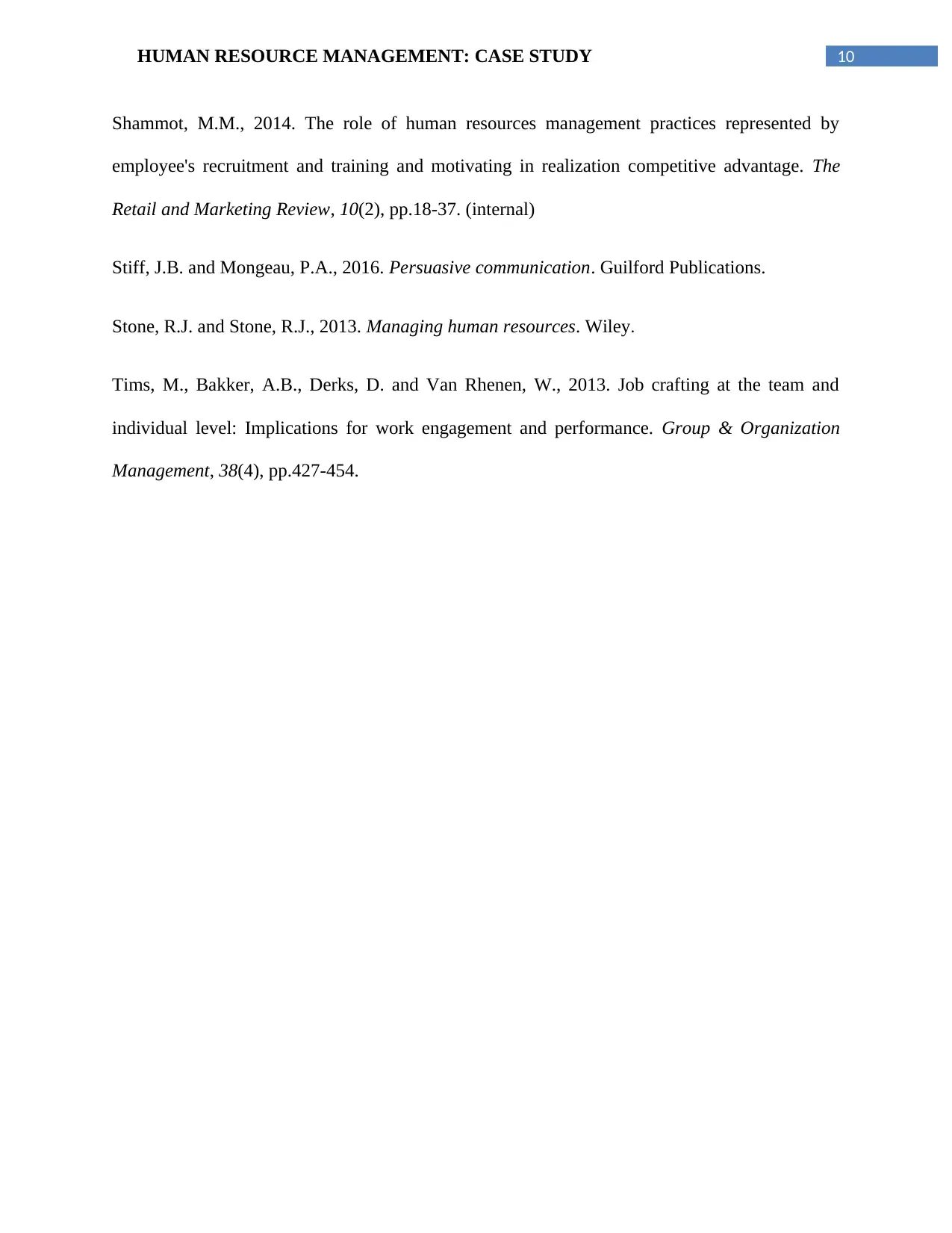
10HUMAN RESOURCE MANAGEMENT: CASE STUDY
Shammot, M.M., 2014. The role of human resources management practices represented by
employee's recruitment and training and motivating in realization competitive advantage. The
Retail and Marketing Review, 10(2), pp.18-37. (internal)
Stiff, J.B. and Mongeau, P.A., 2016. Persuasive communication. Guilford Publications.
Stone, R.J. and Stone, R.J., 2013. Managing human resources. Wiley.
Tims, M., Bakker, A.B., Derks, D. and Van Rhenen, W., 2013. Job crafting at the team and
individual level: Implications for work engagement and performance. Group & Organization
Management, 38(4), pp.427-454.
Shammot, M.M., 2014. The role of human resources management practices represented by
employee's recruitment and training and motivating in realization competitive advantage. The
Retail and Marketing Review, 10(2), pp.18-37. (internal)
Stiff, J.B. and Mongeau, P.A., 2016. Persuasive communication. Guilford Publications.
Stone, R.J. and Stone, R.J., 2013. Managing human resources. Wiley.
Tims, M., Bakker, A.B., Derks, D. and Van Rhenen, W., 2013. Job crafting at the team and
individual level: Implications for work engagement and performance. Group & Organization
Management, 38(4), pp.427-454.
1 out of 11
Related Documents
Your All-in-One AI-Powered Toolkit for Academic Success.
+13062052269
info@desklib.com
Available 24*7 on WhatsApp / Email
![[object Object]](/_next/static/media/star-bottom.7253800d.svg)
Unlock your academic potential
Copyright © 2020–2025 A2Z Services. All Rights Reserved. Developed and managed by ZUCOL.



